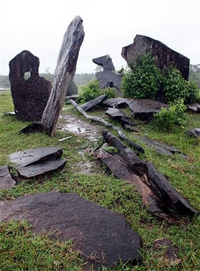Astronomical observatory built by early forest inhabitants found in Brazil
On the shortest day of the year - December 21 - the shadow of one of the blocks disappears when the sun is directly above it.

"It is this block's alignment with the winter solstice that leads us to believe the site was once an astronomical observatory," said Mariana Petry Cabral, an archaeologist at the Amapa State Scientific and Technical Research Institute.
Anthropologists have long known that local indigenous populations were acute observers of the stars and sun.
But the discovery of a physical structure that appears to incorporate this knowledge suggests pre-Columbian Indians in the Amazon rain forest may have been more sophisticated than previously suspected.
Scientists belive it was once inhabited by the ancestors of the Palikur Indians, and while the blocks have not yet been submitted to carbon dating, she says pottery shards near the site indicate they are pre-Columbian and maybe older - as much as 2,000 years old, CNN reports.
Last month, archaeologists working on a hillside north of Lima, Peru, announced the discovery of the oldest astronomical observatory in the Western Hemisphere - giant stone carvings, apparently 4,200 years old, that align with sunrise and sunset on December 21.
While the Incas, Mayans and Aztecs built large cities and huge rock structures, pre-Columbian Amazon societies built smaller settlements of wood and clay that quickly deteriorated in the hot, humid Amazon climate, disappearing centuries ago, archaeologists say.
Archeologists got involved last year after geographers and geologists did a socio-economic survey of the area, by foot and helicopter, and noticed "the unique circular structure on top of the hill," Cabral said.
Scientists not involved in the discovery said it could prove valuable to understanding pre-Columbian societies in the Amazon, according to the AP.
Subscribe to Pravda.Ru Telegram channel, Facebook, RSS!


